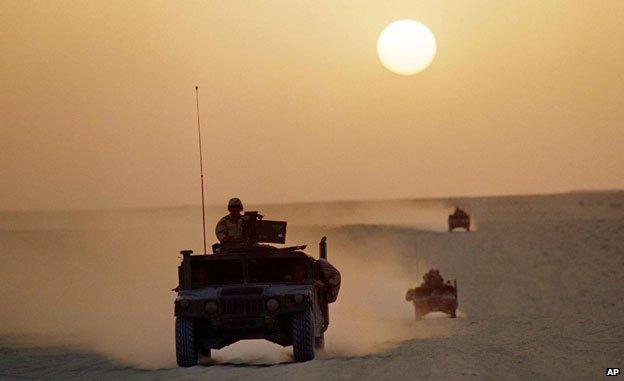Who, What, Why: What is a defensive weapon?
- Published

President Obama is being urged to supply Ukraine with "defensive lethal assistance", which sounds almost like a contradiction in terms. James Morgan asks what people mean by "defensive" weapons - and finds out it's what a hedgehog has.
It's widely believed in the US, and in other Nato countries, that Russia is not only arming the rebels but sending soldiers to fight alongside them, so the pressure is increasing on the White House to ramp up military supplies to the Ukrainian government to help it resist a new offensive.
Currently the US only provides non-lethal equipment, such as gas masks, night-vision goggles and radar. How much further can it go without escalating the conflict or being seen as an aggressor?
A report by three US think-tanks, external this week calls for more non-lethal aid - such as drones, secure communications equipment and armoured Humvees - but also "defensive" lethal assistance, specifically anti-tank missiles.
"Ukrainian light anti-armour capabilities are severely lacking at a time when the Russians have moved large numbers of tanks and armoured personnel carriers into the Donbass," the report says.
But can a missile really be "defensive"?
"Any weapon is defensive if you're using it to defend yourself or your country," says Colin Clark, editor of Breaking Defense magazine. "And since Putin is the aggressor here, if we supply weapons to those fighting against him they are, by definition, defensive."
But equally, if President Putin supplies the rebels with arms "he might simply say he is 'defending' the rights of Russians," Clark adds.
Looking at it this way, it would seem almost any weapon could qualify as "defensive" - rendering the term meaningless.
In practice, however, "there are distinctions" says Clark. In Ukraine, for instance, the US is unlikely to supply any arms which might "turn the tide of war" and allow Ukrainian troops to advance or invade opposition territory.
Fighter jets, heavy artillery and ground troops would all fall into this category. But anti-tank missiles - such as the Javelin missile requested by Ukrainian military - "would not be much use if you wanted to attack someone" says Clark. "They can blow holes in armour but they're not going to cause huge explosions and kill lots of people."
Paul Scharre, a former Pentagon official, now a senior fellow at the Center for a New American Security, points to the defensive use of precision anti-tank missiles against Israeli artillery in 2006. "They couldn't stop Israel, but they slowed them down - at a cost to their military. It helped Hezbollah defend their territory," he says.

US marine Humvees in Saudi Arabia as part of Operation Desert Shield in 1990
Light armoured vehicles, are also defensive, he suggests, even if they carry guns.
"They might allow IS to take empty swathes of desert, but they couldn't be used to attack any sophisticated military," he says.
"If you're looking for a metaphor - think about a hedgehog. Its spikes are prickly but ultimately they are only useful in defence. So how can the US make Ukraine more hedgehog-like? More spiky and harder to attack?"
Subscribe to the BBC News Magazine's email newsletter to get articles sent to your inbox